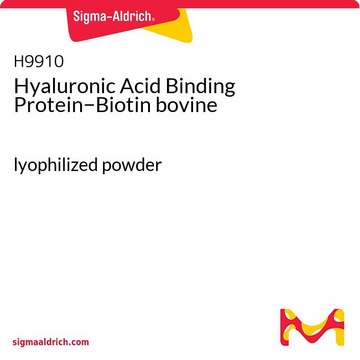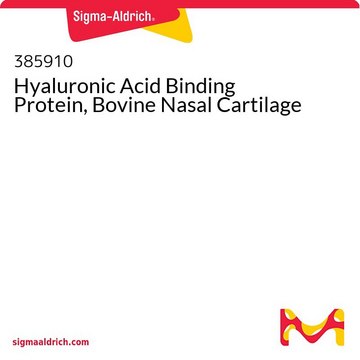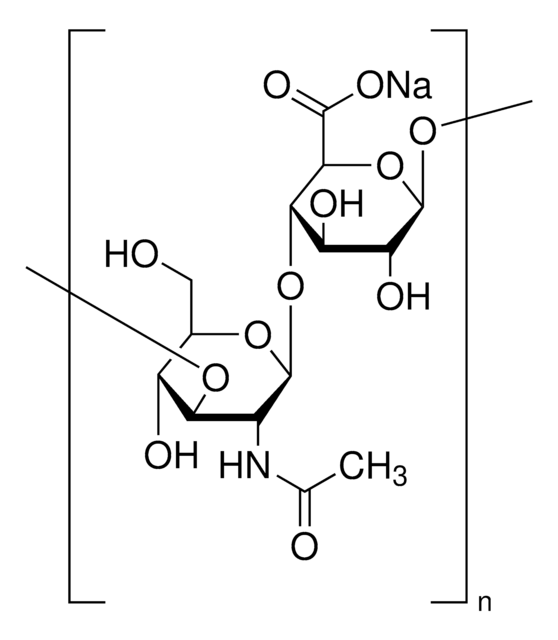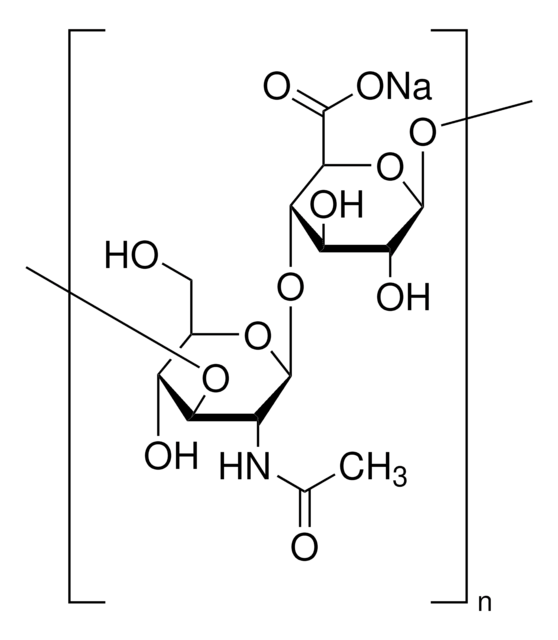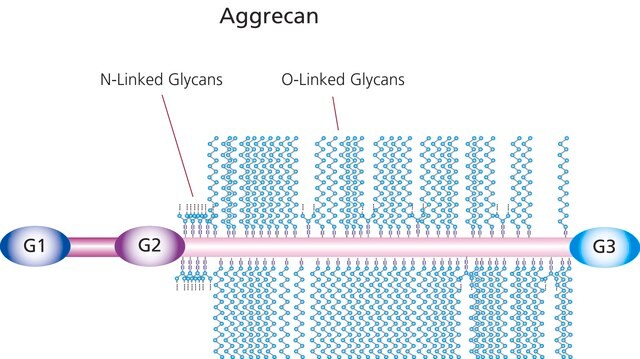H0161
Hyaluronic Acid Binding Protein bovine
lyophilized powder
Autenticatiper visualizzare i prezzi riservati alla tua organizzazione & contrattuali
About This Item
Prodotti consigliati
Origine biologica
bovine
Livello qualitativo
Forma fisica
lyophilized powder
tecniche
immunofluorescence: suitable
N° accesso UniProt
Temperatura di conservazione
−20°C
Informazioni sul gene
cow ... VCAN(282662)
Descrizione generale
Hyaluronic acid (HA) is a linear polysaccharide consisting of a repeating disaccharide of N-acetyl D-glucosamine (GlcNAc) and D-glucuronic acid (GlcA) with 1→4 interglycosidic linkages and these disaccharide repeating units are in turn linked by β (1→3) linkages. The number of repeating disaccharides in a HA molecule ranges from 2,000 to 25,000, which relates to a molecular mass of 106-107. The unique biological roles of HA is mainly due to the specific binding and interaction with HA-binding proteins also known as hyaladherins. Most hyaladherins is composed of a specific binding domain, also called a link module, which is composed of two α-helices and two antiparallel β-sheets.
Karl Meyer and John Palmer first isolated hyaluronic acid (HA) from the vitreous of bovine eyes. They coined the name “hyaluronic acid” as a conjugation of two words, hyaloid (vitreous) and uronic acid. HA has an extended random coil structure in physiological solution. Due to its random-coil structure and high molecular weight (HMW), HA forms very viscose and elastic solution with a huge hydrodynamic volume.
Applicazioni
Hyaluronic Acid Binding Protein bovine may be used for incubation of specimens for immunofluorescence analysis of human megakaryocytes.
Azioni biochim/fisiol
Hyaluronic Acid Binding Protein (HABP) levels increases during oocyte maturation and it promotes cumulus expansion during in vitro maturation.
In addition to being an important structural component of tissues in all vertebrates, HA is also associated with several biological functions including intracellular signaling.
May be useful in hyaluronic acid binding or detection.
Codice della classe di stoccaggio
11 - Combustible Solids
Classe di pericolosità dell'acqua (WGK)
WGK 3
Punto d’infiammabilità (°F)
Not applicable
Punto d’infiammabilità (°C)
Not applicable
Dispositivi di protezione individuale
Eyeshields, Gloves, type N95 (US)
Certificati d'analisi (COA)
Cerca il Certificati d'analisi (COA) digitando il numero di lotto/batch corrispondente. I numeri di lotto o di batch sono stampati sull'etichetta dei prodotti dopo la parola ‘Lotto’ o ‘Batch’.
Possiedi già questo prodotto?
I documenti relativi ai prodotti acquistati recentemente sono disponibili nell’Archivio dei documenti.
I clienti hanno visto anche
Hyaluronan based hydrogels provide an improved model to study megakaryocyte-matrix interactions
Currao M, et al.
Experimental Cell Research, 346(1), 1-8 (2016)
Identification of hyaluronic acid-binding proteins and their expressions in porcine cumulus-oocyte complexes during in vitro maturation
Yokoo M, et al.
Biology of Reproduction, 67(4), 1165-1171 (2002)
A G Haus
Radiologic clinics of North America, 25(5), 913-928 (1987-09-01)
Today there are many dedicated mammographic x-ray units available that are capable of providing high-quality screen-film mammograms. Likewise, screen-film combinations designed for mammography are capable of providing images with appropriate contrast, resolution, and noise levels. Proper film processing is most
G Perides et al.
The Journal of biological chemistry, 264(10), 5981-5987 (1989-04-05)
A glial hyaluronate-binding protein (GHAP) with an isoelectric point of 4.3-4.4 was isolated from human brain white matter. The 60-kDa glycoprotein appeared to be quite resistant to proteolysis, and comparison with GHAP from a viable glioma removed at surgery showed
Il team dei nostri ricercatori vanta grande esperienza in tutte le aree della ricerca quali Life Science, scienza dei materiali, sintesi chimica, cromatografia, discipline analitiche, ecc..
Contatta l'Assistenza Tecnica.